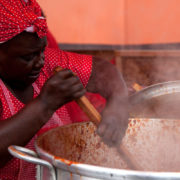Rooted in slavery, the food of Afro-Peruvians is an integral part of Peru’s culinary identity.
Millions of tourists travel to Peru every year to eat. The draw is Lima’s unique comida criolla (creole cuisine)—the 500-year fusion of Andean, Spanish, African, Chinese, and Japanese culinary cultures. The cuisine is famous for dishes like spicy and citrusy ceviche; cubed sole tossed with salt, limes, hot peppers, and onions; or the ginger and soy sauce stir-fry of steak, onions, tomatoes, and French fries that is lomo saltado. But some of Peru’s most iconic street foods, from grilled beef-heart anticuchos marinated in a vinegar sauce to the deep-fried doughnut-like picarones made from spiced sweet potatoes, come from a legacy of slavery.
Sixteenth-century conquistadors brought Black slaves from various African tribes to the Viceroyalty of Peru. Some slaves came from the Iberian Peninsula or the Caribbean, already spoke Spanish, and were familiar with European dishes. In Lima, they cooked in upper-class homes or performed skilled urban labor. In the Andes, they mined for silver and gold. And on coastal haciendas, slaves worked in vineyards and sugarcane or cotton plantations. Through this oppression, Black slaves gave birth to cuisine and music that their descendants have preserved across generations.
Featured Image, NICHOLAS GILL
Full article @ TASTE
Context
Peruvian cuisine
Peruvian cuisine reflects local practices and ingredients including influences mainly from the indigenous population, including the Inca, and cuisines brought by immigrants from Europe (Spanish cuisine, Italian cuisine, German cuisine); Asia (Japanese cuisine and Chinese cuisine); and Africa. Without the familiar ingredients from their home countries, immigrants modified their traditional cuisines by using ingredients available in Peru.
The four traditional staples of Peruvian cuisine are corn, potatoes and other tubers, and Amaranthaceaes (quinoa, kañiwa and kiwicha) and legumes (beans and lupins). Staples brought by the Spanish include rice, wheat and meats (beef, pork and chicken).
Many traditional foods—such as quinoa, kiwicha, chili peppers, and several roots and tubers—have increased in popularity in recent decades, reflecting a revival of interest in native Peruvian foods and culinary techniques. Chef Gaston Acurio has become well known for raising awareness of local ingredients. The most important ingredient in all Peruvian cuisine is the potato, as Peru has the widest variety of potatoes in the world.
Source – Peruvian cuisine (Updated: 7 September 2020) Wikipedia. Available at https://en.wikipedia.org/wiki/Peruvian_cuisine: (Accessed: 23 September 2020)

